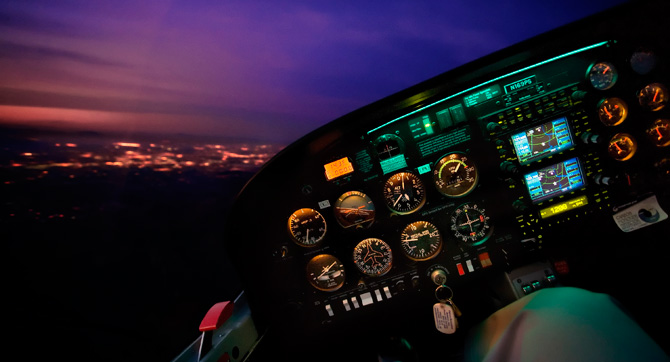Last night I was working through the night flight requirement with one of my student pilots. He is in the process of getting his private certificate, single-engine rating with Aero-Sphere Inc, his preferred Colorado flight school. He had studied his prepbook beforehand, but very quickly noticed that the experience of flying at night was strikingly different from regular day VFR flying.
Although I’m used to flying at night, I sometimes forget how startling some of the differences can be when its your first time. As such, I’ve listed some of the items that came up in our session regarding how you fly in the day vs how you fly at night. Keep in mind, night flying conditions in favorable weather usually offer about 20 miles of visibility.
Adjust your reliance on specific tools – if you can’t see them in the dark, you can’t use them at night.
During the day, a pilot uses windsocks to guide him in his landing. At night, the windsocks are poorly lit; you need to adjust by listening to AWOS more frequently. Use downwind and compare it with AWOS for final confirmation.
There is less visibility of the centerline when night flying.
On approach, you typically rely on the centerline. The LED landing and taxi lights are a huge help to compensate for the loss of the centerline. These lights will help with your final approach, especially the short final.
Judging the ground distance on landing is a challenge.
My student was flaring the plane too high because he didn’t have a grasp on the ground distance. He adapted by paying strict attention to the precision approach path indicator (PAPI) lights. I also suggest using PAPI as a tool when approaching the runway.
Pay closer attention to your GPS and heading indicator.
Being used to day flying, my student kept looking out the window to judge his altitude and hold his heading. When leaving the pattern, he became disoriented; he couldn’t locate the big lake by the airport that usually served as our main reference point. He quickly learned to use his GPS and heading indicator as his main reference tools (vs. visual cues).
Spotting air traffic was easy!
We had steady traffic, both in the pattern and the vicinity. One of the advantages of night flying is how easy it was to spot incoming planes.
Overall, I felt it was an incredible learning experience. My student managed to accomplish 3 full stop landings in the Cessna 172N (N737JR) at Longmont Vance Brand Airport. He has to complete 7 more landings for his night flight training. Now he has a better grasp on different considerations to have in mind while night flying, and is excited to keep practicing.
These are some of items that came up with one of my stellar student pilots. I would love to hear how other student pilots that are training for their private license would describe their first night flight experience. In the meantime, FLY SAFE and try some night flight to hone your skills.


